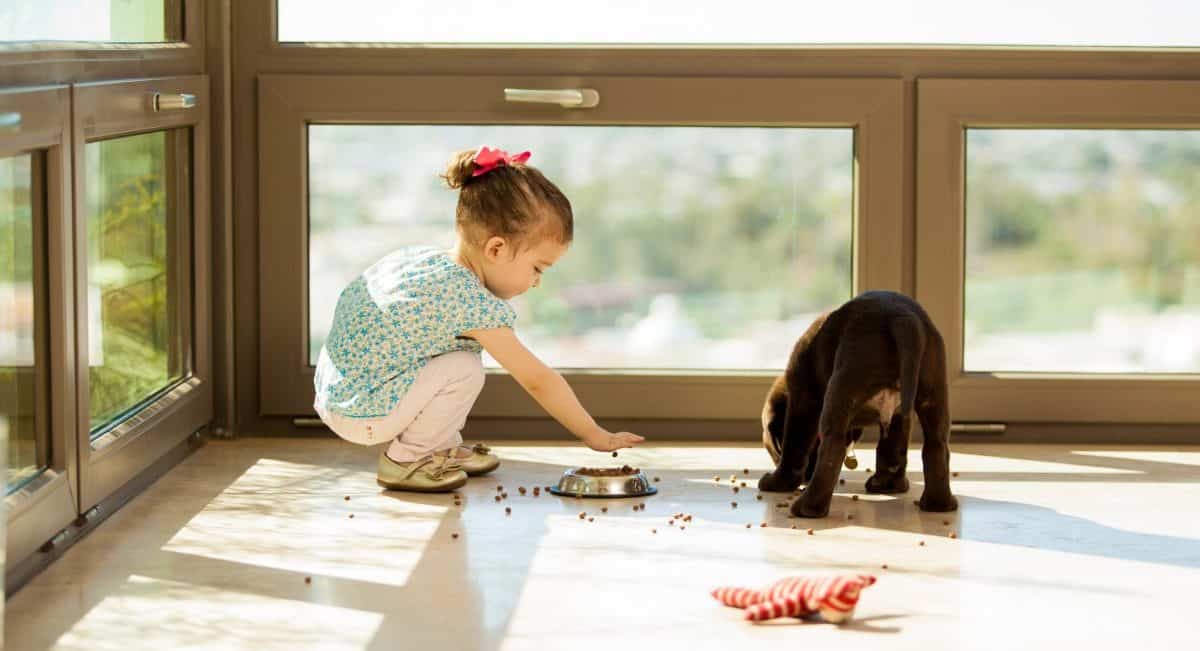Affiliate Disclosure: This post may contain affiliate links. If you make a purchase after clicking on these links I will be compensated at no extra cost to you. However, I never recommend anything I don’t love or wouldn’t use myself!
Ever had that dreadful realization that your toddler has been helping themselves to the pet’s food? I have pried dog and cat food from my children’s mouths on too many occasions to admit to. Having done some research, I’ve written this article to help others in the same situation.
So, is eating pet food dangerous for children? Pet food is generally not harmful to kids as it’s main constituents are meat by-products, cereals, and vegetables. However, pet food has been linked to salmonella outbreaks and larger chunks may present a choking hazard. Animals such as dogs may show signs of aggression when protecting their food.
It’s very common for babies and toddlers to get their hands on the pet food. If your child has eaten some, most of the time there is absolutely nothing to worry about. However, pet food does not always come under the same scrutiny as food for human consumption. It’s important to understand the potential risks involved and how to avoid them.
Contaminated Pet Food
In the U.S. the FDA (Food and Drug Administration) helps to regulate the pet food industry and implements pet food recalls and withdrawals to reduce risk to pets and their owners.
A large proportion of recalls are due to contamination or potential contamination including Salmonella, Listeria, E. Coli and more. Although these are often just precautional measures, the potential for outbreaks is real.
Aside from pets, younger kids are often the first to be affected by contaminated pet food. Even if they don’t actually eat the food, some may just handle it and go on to put their fingers in their mouths later.
If your child does come into contact with pet’s food, there is usually no reason to panic, however, you should monitor your child closely and consult a medical professional if you notice any abnormal symptoms.
If you are worried about contamination, you can check the FDA webpage for recalls and withdrawals.
Some good practices to minimize risks to you and your kids are as follows:
- Wash hands regularly, particularly after coming into contact with pets food
- Clean pet’s dishes and feeding areas regularly
- Keep up to date with vaccinations and worming to cut down risks of cross-species parasites
Nutritional Risks Of Consuming Pet Food
Nutritionally speaking, eating pet food is not likely to cause any major issues although it’s a little offputting, to say the least.
The formulas for dog and cat food differ slightly as they have different nutritional requirements. However, They’re both mostly made up from slaughterhouse leftovers, such as organs, trim, blood and hides along with corn kernels, barley, wheat, and rice. Cat food may also contain additives crucial for a cats health.
In small doses, these will not cause your child any issues but it’s certainly not advised to ingest significant quantities of pet food over prolonged periods.
Food Aggression In Dogs
A lot of dogs may instinctually show signs of aggression if approached while eating or if they feel like their food source is at risk. This isn’t necessarily a show of dominance, more often it is a sign of anxiety or fear.
There are training techniques to try and reduce acts of food aggression in your dog. Regardless, if your child is taking food from under the dog’s nose it can be a recipe for disaster and should be avoided at all costs.
So with risks of infection, choking and dog bites, eating pet food can present a real danger for children. Below are some useful tips to stop your kids from eating pet food.
How Do I Stop My Child From Eating Pet Food?
- Don’t overreact when you catch your child in the act
- Consider a baby proof feeding bowl such as a microchip feeder
- Feed your pet in a separate closed off room or outside
- Teach your pet to stop “grazing/free feeding”
- Feed your pet when your child is otherwise occupied
- Elevate cat bowls out of your children’s reach
Don’t Overreact When You Catch Your Child In The Act
Even though it may be the knee-jerk response, abruptly shrieking or yelling will usually end in tears or just increase the temptation for the forbidden. To the other extreme, laughing certainly won’t help and will likely encourage the behavior. It’s better to act swiftly in diverting your child’s attention before removing the pet food from reach, rather than making it into a big deal.
Baby Proof Pet Feeders
These can be a little pricey but If you’re willing to shell out some money, then they can provide a stress-free solution to the problem. They are mainly designed to stop pets from eating each other’s food, but will also prevent infants and toddlers from gaining access.
Most models work by reading your pet’s microchip or they will provide a tag which can be attached to your pet’s collar. The food is placed in a bowl which is enclosed and locked under an airtight lid. When your pet approaches, the bowl will read your pets microchip or tag and will automatically open, ensuring access is only granted to the intended pet.
These allow grazing pets to eat freely, without you having to worry about your child (or other pets) helping themselves in the meantime.
One drawback is that microchip feeders are only really designed for smaller dogs and cats so if you have a larger dog this may not be an option.
Feed Your Pets Elsewhere
Out of sight, out of mind; is particularly true when it comes to infants or toddlers and their temptations. Obviously, your kids won’t eat what they can’t see or touch, so this can be the simplest and most effective method. If you’re able to feed your pets away from the kids, possibly outside or somewhere like a utility room or even the bathroom then great.
The trouble is that not everyone has the space to do so or it may just be a big inconvenience. Some pets like to graze and need frequent access to their food. Placing the feeding bowls elsewhere behind closed doors may not seem like an option. If this is the case for your pet, you may want to consider the next point…
Teach Your Pet To Stop “Grazing/Free Feeding”
If your pet is a bit of a sporadic eater and they like to nibble a bit here and there, their food is often left lying around for long periods. This means the pet food is always readily available for your child to have a little graze on too!
There are several reasons why this type of feeding can be detrimental to your dog also. However, stopping your pet from grazing may be easier than you think.
Decide on how much food a day your dog actually needs. You can check your pet food manufacturer’s recommendations. Bear in mind this is only really a rough guide and is often more than your dog actually requires.
Once you’ve decided on a daily quantity, divide it into portions throughout the day.
Around two feeds a day is generally appropriate for most adult cats and dogs (unless advised otherwise by your vet). You may find this number varies for you and your pet.
After giving your pet a portion of food, remove the food bowl around 5 to 10 minutes later, whether they have finished eating or not.
You will be surprised at how quickly your pets feeding habits will change. With a little tough love, your pet will soon learn to eat within the allotted time.
Feed Your Pets When Your Child Is Otherwise Occupied
Distraction is often a parent’s best weapon. If you have your pets feeding habits under control, A great way to prevent your child from eating the pet’s food is to only feed the pet when your child is pre-occupied or even asleep (if you’re privy to this luxury).
Synchronizing your pet’s and kid’s meal times can also work. If you have issues with your kids feeding dogs at the dining table (as I do), not only will it prevent your child from eating the dog food but it may also prevent the dog from eating your child’s food too, at least momentarily!
Elevate Cat Bowls Out Of Your Children’s Reach
The good thing about cats is that they usually enjoy being up high and out of reach, particularly when eating. Putting your cat’s food up on a higher surface will also allow your cat to eat in peace without fear of being bothered by your little ones.
One slight warning, just be careful which counters you allow your cat onto, or they may just think that it’s a free for all.
We tried this ourselves in the kitchen. Ever since our cat has begun treating the kitchen counters as her own personal dining table. She even helped herself to a cup of coffee on one occasion!

